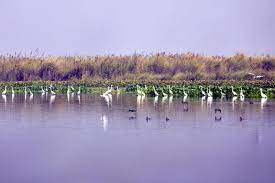Harike Wetland is located in Punjab. It is a remarkable natural treasure and one of the largest wetlands in northern India. It has rich biodiversity and carries great ecological importance. In this article, we will explore the unique features, wildlife, conservation efforts, and recreational opportunities offered by Harike Wetland.

Table of Contents
Introduction to Harike Wetland
Harike Wetland is situated at the confluence of the Beas and Sutlej rivers near the town of Makhu in Punjab. Spanning an area of approximately 41 square kilometers, it serves as a vital habitat for a wide range of migratory and resident bird species.
Biodiversity and Wildlife
Harike Wetland is renowned for its diverse flora and fauna. It provides a vital feeding and nesting ground for numerous avian species, making it a birdwatcher’s paradise. Over 360 species of birds have been recorded here, including the rare Indus River Dolphin, Sarus Crane, Indian Skimmer, and various species of ducks, geese, and waders.
Apart from birds, the wetland also supports a variety of aquatic life, including fish, amphibians, and reptiles. The surrounding vegetation includes submerged and emergent plants, providing important nesting and breeding grounds for several species.
Conservation Efforts in Harike Wetland
The conservation of the Wetland has been a priority for the Punjab Forest Department and various environmental organizations. Several initiatives have been implemented to preserve its fragile ecosystem and protect the diverse wildlife it harbors.
Conservation efforts include strict monitoring of water quality, prevention of pollution, and the implementation of sustainable management practices. The Punjab Forest Department conducts regular surveys and studies to monitor the health of the wetland and assess the impact of human activities.
Recreational Activities and Tourism
It offers a host of recreational activities for visitors. Nature enthusiasts can indulge in birdwatching, photography, and boating to explore the wetland’s breathtaking vistas and observe the vibrant birdlife. Boat rides are particularly popular, providing a unique opportunity to witness the avian diversity up close.
The Harike Wildlife Sanctuary, adjacent to the wetland, provides additional opportunities for wildlife viewing and nature trails. The sanctuary is home to various mammal species, including wild boar, Sambar deer, and Indian jackal.
Cultural Significance
Harike Wetland holds cultural significance in Punjab. It is considered a sacred place and is associated with religious beliefs and local traditions. The annual Harike Fair, held in November, attracts devotees who come to offer prayers and seek blessings.
Conclusion
It stands as a vibrant ecosystem, nurturing a diverse array of bird and animal species. Its breathtaking beauty, ecological significance, and recreational opportunities make it a must-visit destination for nature lovers and wildlife enthusiasts. Through conservation efforts and responsible tourism, Harike Wetland continues to thrive as a sanctuary for biodiversity, contributing to the preservation of Punjab’s natural heritage for future generations to cherish.
Important Links